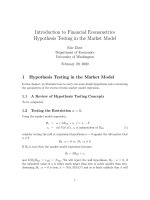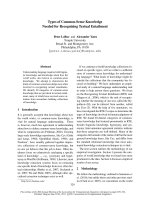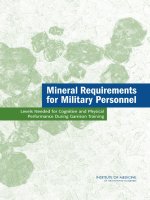Distribution needed for hypothesis testing
Bạn đang xem bản rút gọn của tài liệu. Xem và tải ngay bản đầy đủ của tài liệu tại đây (95.93 KB, 4 trang )
Distribution Needed for Hypothesis Testing
Distribution Needed for
Hypothesis Testing
By:
OpenStaxCollege
Earlier in the course, we discussed sampling distributions. Particular distributions are
associated with hypothesis testing. Perform tests of a population mean using a normal
distribution or a Student's t-distribution. (Remember, use a Student's t-distribution when
the population standard deviation is unknown and the distribution of the sample mean
is approximately normal.) We perform tests of a population proportion using a normal
distribution (usually n is large or the sample size is large).
If you are testing a single population mean, the distribution for the test is for means:
¯
X ~ N μX ,
(
σX
√n
) or t
df
¯
The population parameter is μ. The estimated value (point estimate) for μ is x, the
sample mean.
If you are testing a single population proportion, the distribution for the test is for
proportions or percentages:
( √ )
P ′ ~ N p,
p⋅q
n
The population parameter is p. The estimated value (point estimate) for p is p′. p′ =
where x is the number of successes and n is the sample size.
x
n
Assumptions
When you perform a hypothesis test of a single population mean μ using a Student's
t-distribution (often called a t-test), there are fundamental assumptions that need to be
met in order for the test to work properly. Your data should be a simple random sample
that comes from a population that is approximately normally distributed. You use the
sample standard deviation to approximate the population standard deviation. (Note that
1/4
Distribution Needed for Hypothesis Testing
if the sample size is sufficiently large, a t-test will work even if the population is not
approximately normally distributed).
When you perform a hypothesis test of a single population mean μ using a normal
distribution (often called a z-test), you take a simple random sample from the
population. The population you are testing is normally distributed or your sample size
is sufficiently large. You know the value of the population standard deviation which, in
reality, is rarely known.
When you perform a hypothesis test of a single population proportion p, you take
a simple random sample from the population. You must meet the conditions for a
binomial distribution which are: there are a certain number n of independent trials, the
outcomes of any trial are success or failure, and each trial has the same probability of
a success p. The shape of the binomial distribution needs to be similar to the shape of
the normal distribution. To ensure this, the quantities np and nq must both be greater
than five (np > 5 and nq > 5). Then the binomial distribution of a sample (estimated)
pq
proportion can be approximated by the normal distribution with μ = p and σ = n .
Remember that q = 1 – p.
√
Chapter Review
In order for a hypothesis test’s results to be generalized to a population, certain
requirements must be satisfied.
When testing for a single population mean:
1. A Student's t-test should be used if the data come from a simple, random
sample and the population is approximately normally distributed, or the sample
size is large, with an unknown standard deviation.
2. The normal test will work if the data come from a simple, random sample and
the population is approximately normally distributed, or the sample size is
large, with a known standard deviation.
When testing a single population proportion use a normal test for a single population
proportion if the data comes from a simple, random sample, fill the requirements for a
binomial distribution, and the mean number of success and the mean number of failures
satisfy the conditions: np > 5 and nq > n where n is the sample size, p is the probability
of a success, and q is the probability of a failure.
Formula Review
If there is no given preconceived α, then use α = 0.05.
2/4
Distribution Needed for Hypothesis Testing
•
•
•
•
Types of Hypothesis Tests
Single population mean, known population variance (or standard deviation):
Normal test.
Single population mean, unknown population variance (or standard deviation):
Student's t-test.
Single population proportion: Normal test.
For a single population mean, we may use a normal distribution with the
following mean and standard deviation. Means: μ = μ¯ and σ¯ =
x
x
σx
√n
• A single population proportion, we may use a normal distribution with the
pq
following mean and standard deviation. Proportions: µ = p and σ = n .
√
Which two distributions can you use for hypothesis testing for this chapter?
A normal distribution or a Student’s t-distribution
Which distribution do you use when you are testing a population mean and the standard
deviation is known? Assume sample size is large.
Which distribution do you use when the standard deviation is not known and you are
testing one population mean? Assume sample size is large.
Use a Student’s t-distribution
A population mean is 13. The sample mean is 12.8, and the sample standard deviation
is two. The sample size is 20. What distribution should you use to perform a hypothesis
test? Assume the underlying population is normal.
A population has a mean is 25 and a standard deviation of five. The sample mean is 24,
and the sample size is 108. What distribution should you use to perform a hypothesis
test?
a normal distribution for a single population mean
It is thought that 42% of respondents in a taste test would prefer Brand A. In a particular
test of 100 people, 39% preferred Brand A. What distribution should you use to perform
a hypothesis test?
You are performing a hypothesis test of a single population mean using a Student’s tdistribution. What must you assume about the distribution of the data?
It must be approximately normally distributed.
3/4
Distribution Needed for Hypothesis Testing
You are performing a hypothesis test of a single population mean using a Student’s tdistribution. The data are not from a simple random sample. Can you accurately perform
the hypothesis test?
You are performing a hypothesis test of a single population proportion. What must be
true about the quantities of np and nq?
They must both be greater than five.
You are performing a hypothesis test of a single population proportion. You find out
that np is less than five. What must you do to be able to perform a valid hypothesis test?
You are performing a hypothesis test of a single population proportion. The data come
from which distribution?
binomial distribution
Homework
It is believed that Lake Tahoe Community College (LTCC) Intermediate Algebra
students get less than seven hours of sleep per night, on average. A survey of 22 LTCC
Intermediate Algebra students generated a mean of 7.24 hours with a standard deviation
of 1.93 hours. At a level of significance of 5%, do LTCC Intermediate Algebra students
get less than seven hours of sleep per night, on average? The distribution to be used for
¯
this test is X ~ ________________
1.
2.
3.
4.
1.93
N(7.24, √22 )
N(7.24, 1.93)
t22
t21
d
4/4









